1993 CHEVROLET ASTRO PASSENGER air condition
[x] Cancel search: air conditionPage 121 of 345

Downloaded from www.Manualslib.com manuals search engine Charging System Light
Standard Cluster Digital Cluster
3
-
The charging system light will come on briefly when you turn \
the ignition on,
but the engine is not running. As a check to show you the light is working.
Then it should go out once the engine is running.
If it stays on, or comes on
while you are driving,
you may have a problem with the electrical charging
system.
It could indicate that you have a loose accessory drive belt, or
another electrical problem. Have
it checked right away. Driving while this light
is on could drain your battery.
The charging system light is
on the left bottom corner of your standard
cluster. It is part
of the digital cluster voltmeter.
If you must drive a short distance with the light on, be certain to turn off all
your accessories, such as the radio and heater/air conditioner. \
2-65
Page 125 of 345
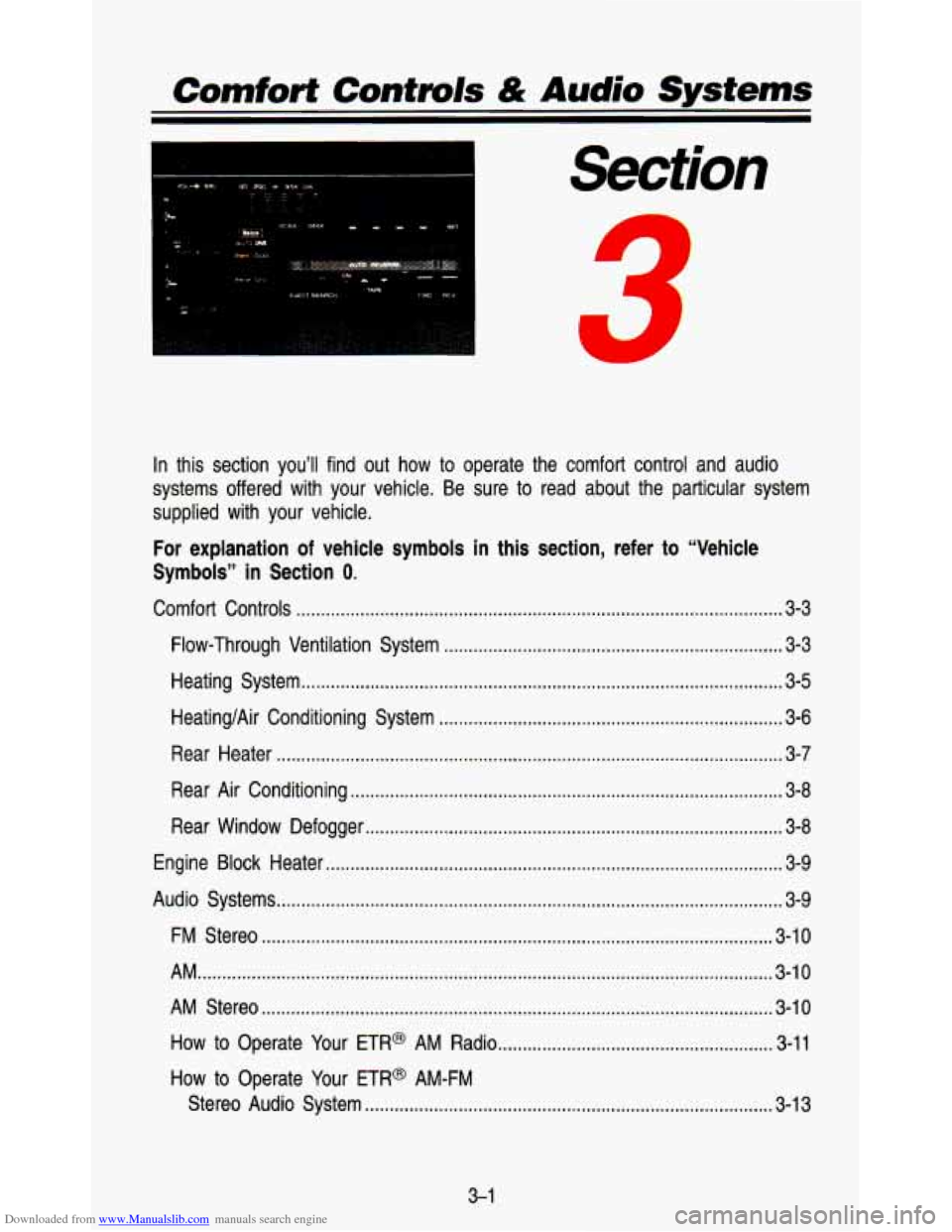
Downloaded from www.Manualslib.com manuals search engine Comfort Controls & Audio Systems
In this section you’ll find out how to operate the comfort control and audio
systems offered with your vehicle. Be sure to read about the \
particular system
supplied with your vehicle.
For explanation of vehicle symbols in this section, refer to “Vehicle
Symbols” in Section 0.
Comfort Controls ........................................................................\
........................... 3-3
Flow-Through Ventilation System
..................................................................... 3-3
Heating System
........................................................................\
.......................... 3-5
Heating/Air Conditioning System
...................................................................... 3-6
Rear Heater
........................................................................\
............................... 3-7
Rear Air Conditioning
........................................................................\
................ 3-8
Rear Window Defogger
........................................................................\
............. 3-8
Engine Block Heater
........................................................................\
..................... 3-9
Audio Systems
........................................................................\
............................... 3-9
FM Stereo ........................................................................\
................................ 3-1 0
AM.. ........................................................................\
........................................... 3-1 0
AM Stereo ........................................................................\
................................ 3-1 0
How to Operate Your ETR@ AM Radio ........................................................ 3-11
How to Operate Your ETR@ AM-FM
Stereo Audio System
........................................................................\
........... 3-1 3
3-1
Page 127 of 345
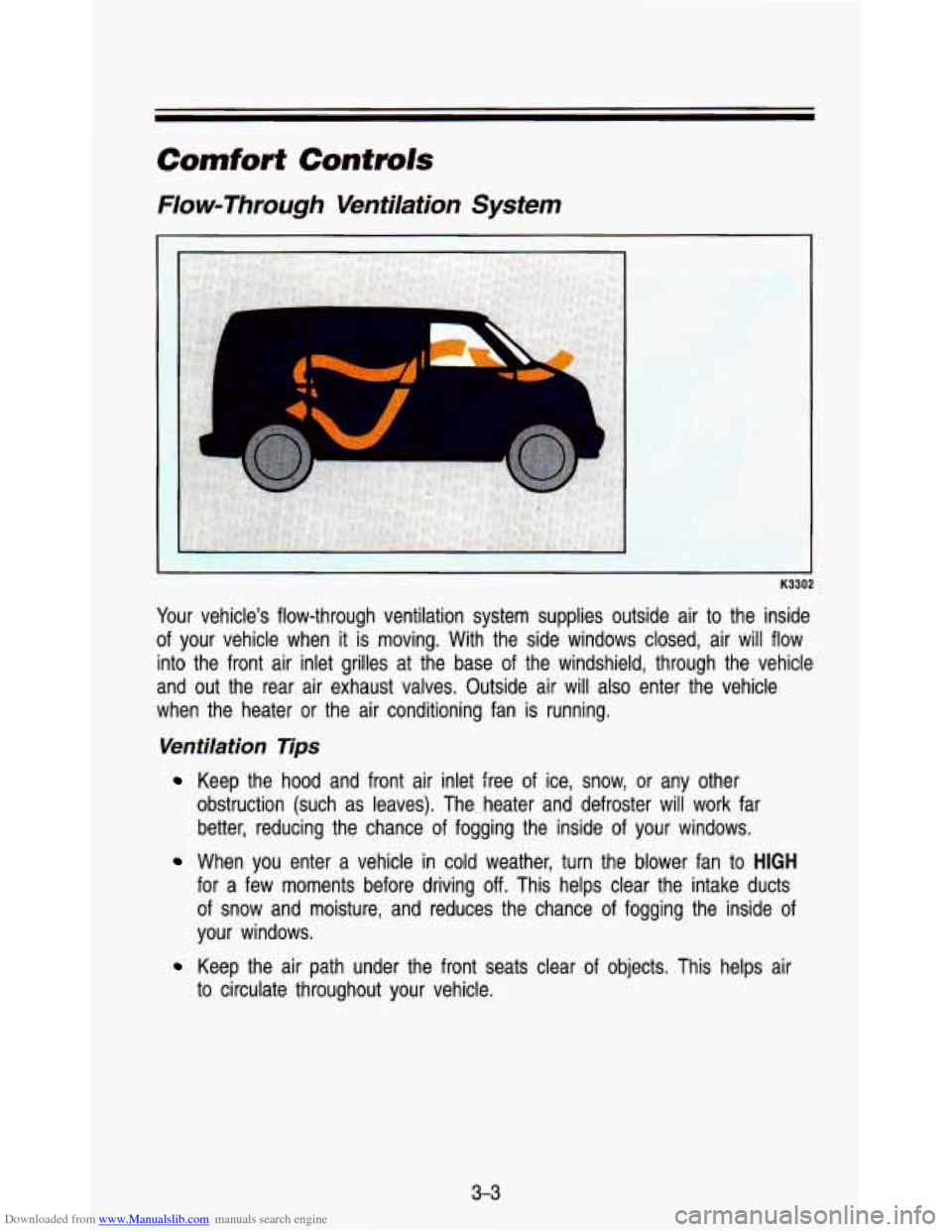
Downloaded from www.Manualslib.com manuals search engine Comfort Controls
Flow-Through Ventilation System
K3302
Your vehicle's flow-through ventilation system supplies outside air to\
the inside
of your vehicle when it is moving. With the side windows closed, air will flow
into the front air inlet grilles at the base
of the windshield, through the vehicle
and out the rear air exhaust valves. Outside air will also en\
ter the vehicle
when the heater or the air conditioning fan is running.
Venfilation Tips
Keep the hood and front air inlet free of ice, snow, or any \
other
obstruction (such as leaves). The heater and defroster will w\
ork far better, reducing the chance of fogging the inside
of your windows.
When you enter a vehicle in cold weather, turn the blower fan\
to HIGH
for a few moments before driving
off. This helps clear the intake ducts
of snow and moisture, and reduces the chance of fogging the i\
nside of
your windows.
Keep the air path under the front seats clear of objects. Thi\
s helps air
to circulate throughout your vehicle.
3-3
Page 129 of 345
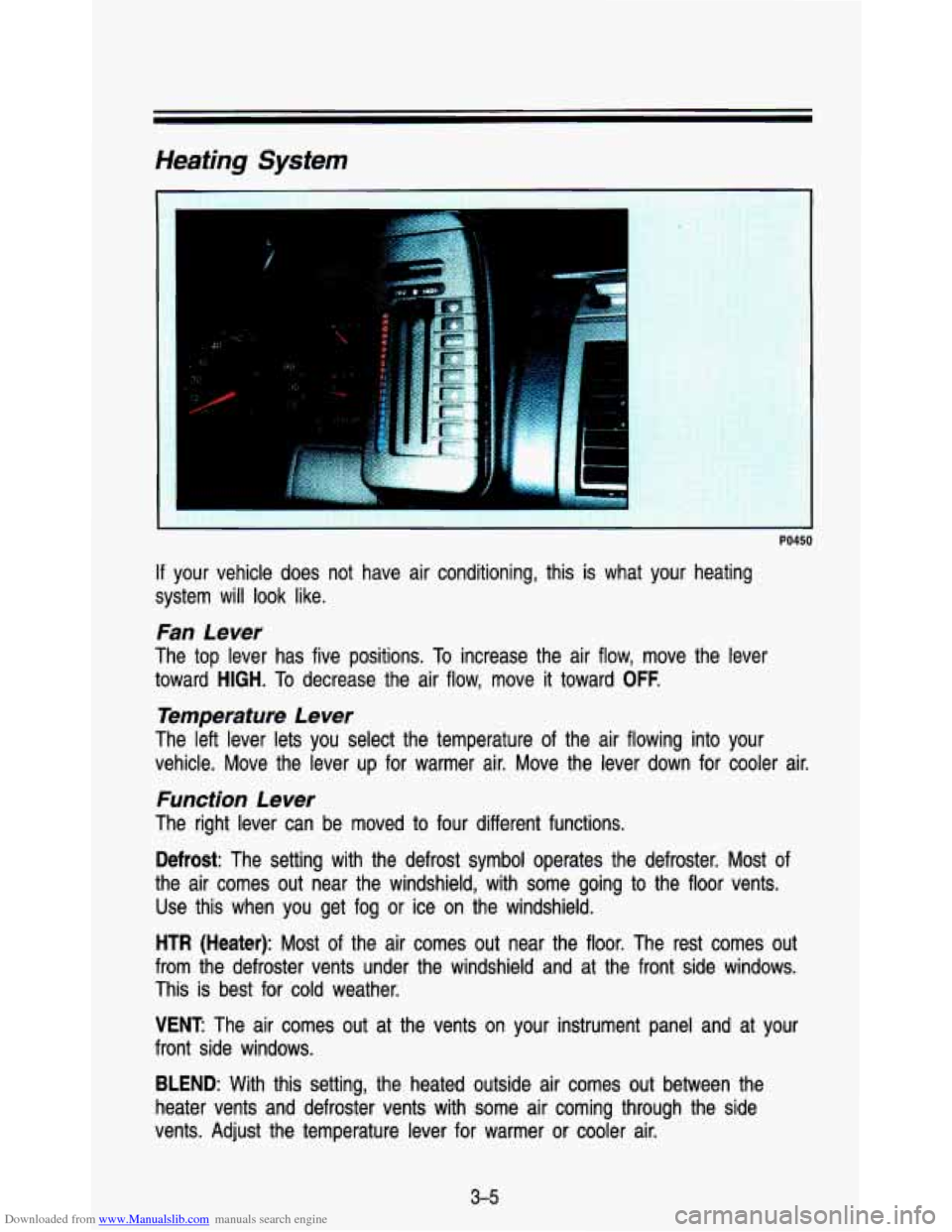
Downloaded from www.Manualslib.com manuals search engine Heating System
PO450
If your vehicle does not have air conditioning, this is what your heating
system will
look like.
Fan Lever
The top lever has five positions. To increase the air flow, move the lever
toward
HIGH. To decrease the air flow, move it toward OFF.
Temperature Lever
The left lever lets you select the temperature of the air flowing into your
vehicle. Move the lever up for warmer air. Move the lever dow\
n for cooler air.
Function Lever
The right lever can be moved to four different functions.
Defrost: The setting with the defrost symbol operates the defroster. Mos\
t of
the air comes out near the windshield, with some going to the floor vents.
Use this when you get fog or ice on the windshield.
HTR (Heater): Most of the air comes out near the floor. The rest comes out
from the defroster vents under the windshield and at the front side windows.
This is best for cold weather.
VENT: The air comes out at the vents on your instrument panel and \
at your
front side windows.
BLEND: With this setting, the heated outside air comes out between the
heater vents and defroster vents with some air coming through \
the side
vents. Adjust the temperature lever for warmer or cooler air.
3-5
Page 130 of 345
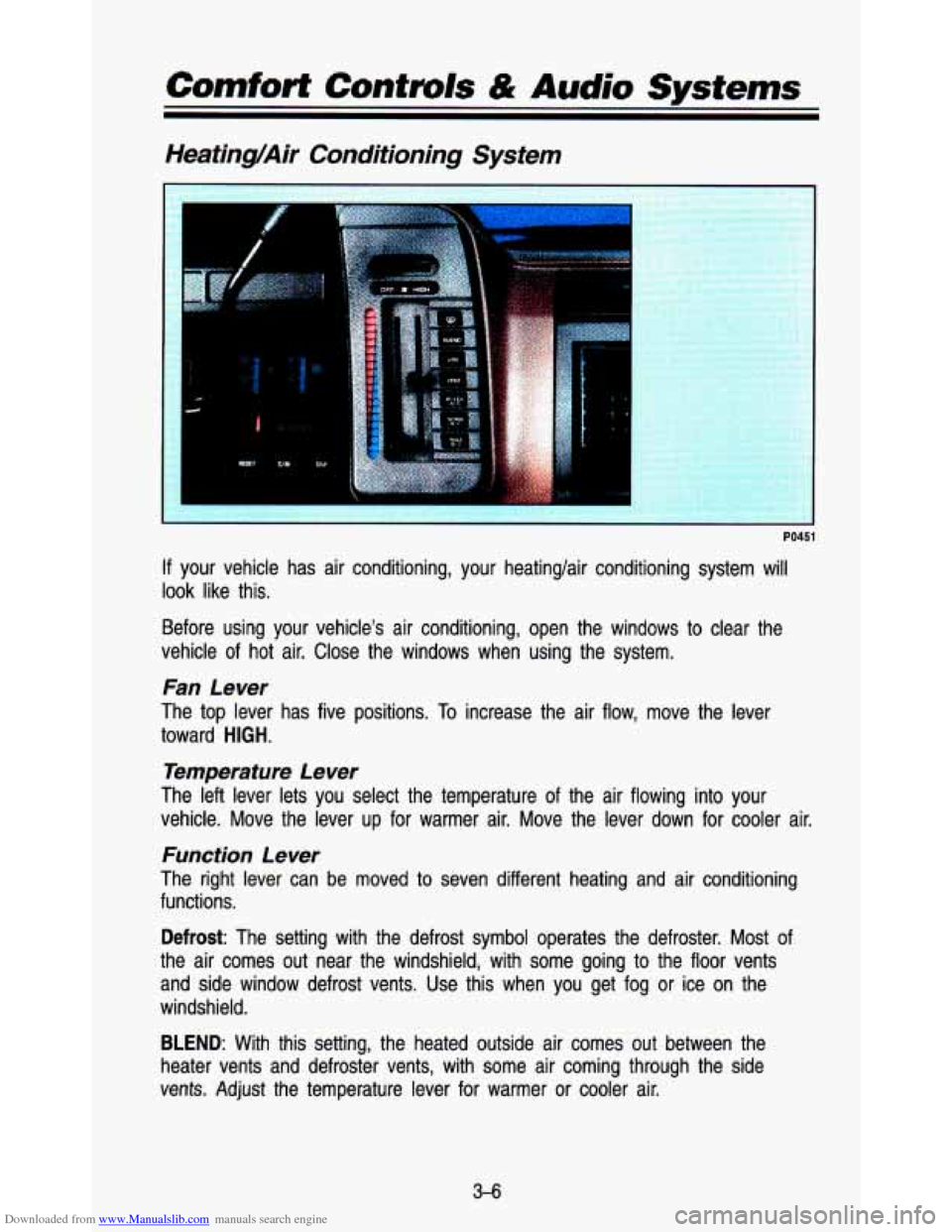
Downloaded from www.Manualslib.com manuals search engine HeatingAir Conditioning System
PO451
If your vehicle has air conditioning, your heating/air conditioning \
system will
look like this.
Before using your vehicle's air conditioning, open the windows to clear the
vehicle of hot air. Close the windows when using the system.
Fan Lever
The top lever has five positions. To increase the air flow, move the lever
toward
HIGH.
Temperature Lever
The left lever lets you select the temperature of the air flowing into your
vehicle. Move the lever up for warmer air. Move the lever down for cooler \
air.
Function Lever
The right lever can be moved to seven different heating and air conditioning
functions.
Defrost: The setting with the defrost symbol operates the defroster. Mos\
t of
the air comes out near the windshield, with some going to the floor vents
and side window defrost vents. Use this when you get fog or ice on the
windshield.
BLEND: With this setting, the heated outside air comes out between th\
e
heater vents and defroster vents, with some air coming through \
the side
vents. Adjust the temperature lever for warmer or cooler air.
3-6
Page 131 of 345

Downloaded from www.Manualslib.com manuals search engine HTR (Heater): Most of the air comes out near the floor. The rest comes out
from the defroster vents under the windshield and at the front\
side windows.
This is best for cold weather.
VENT The air comes out at the vents on your instrument panel and at your
front side windows. The air conditioner will not run. Adjust t\
he temperature
lever for warmer or cooler air.
BI-LEV NC: With this, outside air comes in through the heater floor vent and
the instrument panel vents.
If you move your temperature control lever
between cold and hot, cooler air will come out of the upper vents while
warmer air comes out of the
floor vent. This setting is useful in cool weather
with bright sunlight.
NORM NC: This setting cools the outside air. If you first used MAX NC, use
NORM NC as soon as the vehicle has cooled down, so outside air will be
going through your vehicle.
MAX NC: This cools the air the fastest. Move the other lever all the \
way to
Cold.
MAX A/C lets in only a little air from the outside. You can use MAX
NC at first when it’s really hot outside and you need to cool off quickly.
When the air conditioning or defrost is on, you may notice a slight increase
or decrease in engine .speed.
Rear Heater
You may have the optional rear heater. The three-speed fan switch is above
the radio. Slide the lever toward
HI for warmer air in the rear area. Move the
switch to
OFF to turn the system off.
~ PO654
3-7
Page 132 of 345

Downloaded from www.Manualslib.com manuals search engine Comfort Contmls & Audio Systems
Rear Air Conditioning
You may have rear air conditioning. The rear air conditioning switch is loca\
ted
above the radio at the top of the instrument panel. Slide the lever toward
HI
for cooler air in the rear area. Slide the lever to OFF to turn the system off.
If your vehicle has rear air conditioning, setting it on LOW may enhance front
NC performance by allowing trapped refrigerant in rear lines to circulate.
The system
will only send cooled air if the front system is on. It can still be
used
to recirculate air, even if the front system is off.
Before using the rear air conditioning, open the windows to cl\
ear the vehicle
of hot air. Close the windows when using the system.
Rear Window Defogger
HATCH REL REAR DEFOG
If your vehicle has this option the rear window will have lines \
running across
the glass. These lines heat your window.
For best results, clear the window of as much snow and ice as possible
before using the rear window defogger.
To turn on the rear window defogger, find the switch marked
Rear Defog on
your instrument panel to the left of the steering column. Press the top of the
switch until the light in the switch comes on, then release it. The rear window
defogger will only work when the ignition is in the
RUN position.
You can turn the defogger
off at any time by pressing the bottom of the
switch. The defogger will shut itself
off after several minutes so that the glass
3-8
Page 177 of 345
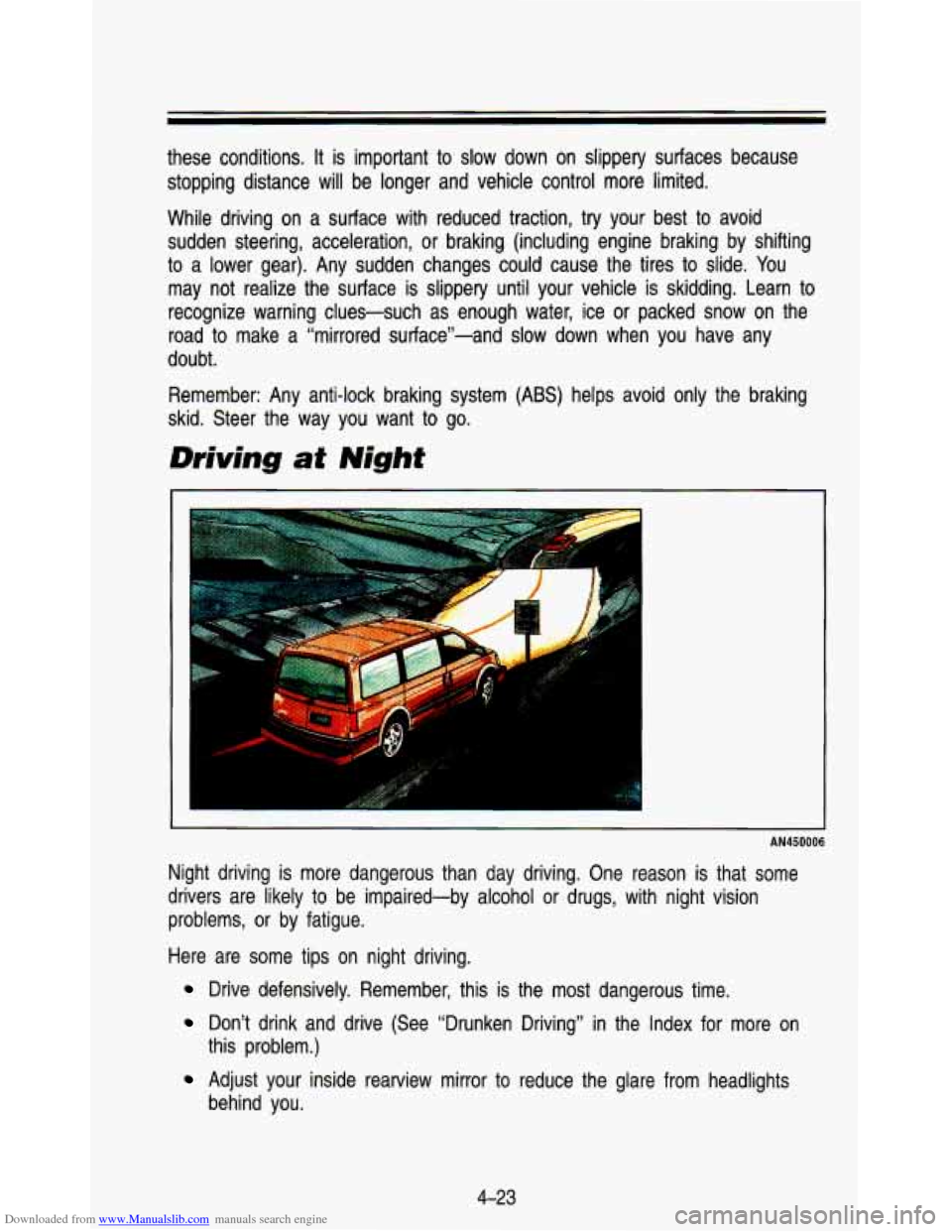
Downloaded from www.Manualslib.com manuals search engine these conditions. It is important to slow down on slippery surfaces because
stopping distance will be longer and vehicle control more limited.
While driving on a surface with reduced traction, try your best to avoid
sudden steering, acceleration, or braking (including engine brak\
ing by shifting
to a lower gear). Any sudden changes could cause the tires to s\
lide. You
may not realize the surface is slippery until your vehicle is skidding. Learn to
recognize warning clues-such as enough water, ice or packed sno\
w on the
road to make a “mirrored sutface”-and slow down when you have any\
doubt.
Remember: Any anti-lock braking system
(ABS) helps avoid only the braking
skid. Steer the way you want to go.
Driving at Night
AN450006
Night driving is more dangerous than day driving. One reason is that some
drivers are likely to be impaired-by alcohol or drugs, with night vision
problems, or by fatigue.
Here are some tips on night driving.
Drive defensively. Remember, this is the most dangerous time.
Don’t drink and drive (See “Drunken Driving” in the Index for more on
Adjust your inside rearview mirror to reduce the glare from he\
adlights
this problem.)
behind you.
4-23